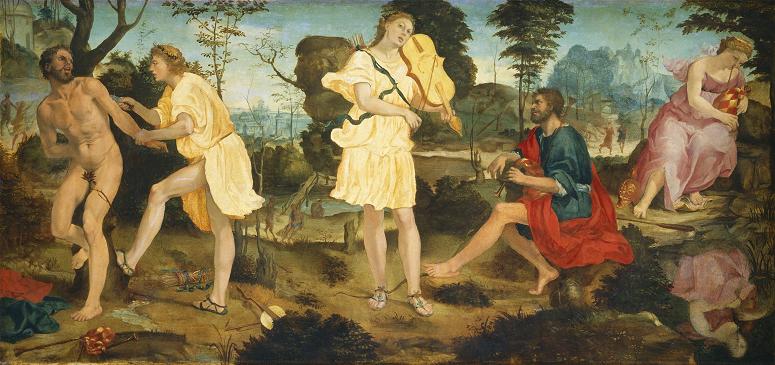Flaying of Marsyas (c1573). Oil on canvas. 212 x 207. The Flaying of Marsyas is a painting by the Italian late Renaissance artist Titian, probably painted between about 1570 and his death in 1576, when in his eighties. It is one of Titian's last works, and may be unfinished, although there is a partial signature on the stone in the foreground. The painting shows the killing by flaying or skinning alive of Marsyas, a satyr who rashly challenged the god Apollo to a musical contest. It is one of several canvases with mythological subjects from Ovid which Titian executed in his late years, mostly the poesie series for King Philip II of Spain, of which this painting seems not to have been part. It did not enter critical literature until 1909. By the 1930s it was widely accepted as an important late work among scholars, but little known by a wider public. On its first modern appearance abroad, it was greeted with astonished admiration as the star attraction of a major exhibition at the Royal Academy in London in 1983, It was new to most viewers and was described by John Russell in the New York Times as the most astonishing picture in the show. Beginning an extended analysis, Sir Lawrence Gowing wrote that All these months-it is not too much to say-London has been half under the spell of this masterpiece, in which the tragic sense that overtook Titian's poesie in his seventies reached its cruel and solemn extreme. At most hours on most days there is a knot of visitors riveted and fairly perplexed in front of it. At the Academy people still ask, and on the radio well-meaning critics debate, how it is possible that a horribly painful subject should be the occasion of beauty or greatness in art. The choice of such a violent scene was perhaps inspired by the death of Marcantonio Bragadin, the Venetian commander of Famagusta in Cyprus who was flayed by the Ottomans when the city fell in August 1571, causing enormous outrage in Venice. Titian's composition is undoubtedly derived from that of Giulio Romano from several decades before. Both artists follow the account in Ovid's Metamorphoses, which covers the contest very quickly, but describes the flaying scene at relative length, though with few indications that would help to visualize it. Marsyas cries out Why do you tear me from myself?. Marsyas was a skillful player of the classical aulos or double flute, for which by Titian's time pan pipes were usually substituted in art, and his set hangs from the tree over his head. Apollo played his usual lyre, which is here represented by a modern lira da braccio, an ancestor of the violin with up to seven strings. This is played by a figure of uncertain identity, who some scholars have said to be Apollo himself, perhaps appearing a second time, since Apollo is clearly the figure wearing a laurel wreath who is kneeling down and using his knife to flay Marsyas' chest. It has also been suggested that the musician is Orpheus, or Olympus, a devoted pupil of Marsyas, who Apollo later converts to playing the lyre, and Ovid mentions. The mythical King Midas, the seated old man on the right, is often thought to be a self-portrait. His downward line of gaze at Marsyas is parallel to that of the musician looking up to the heavens on the other side of the painting. Ovid avoids the question of who the judges of the contest were. In most Greek accounts the Three Muses did the role, but the story early became confused with another, the Judgement of Midas, which has happened here. This was another musical contest, always with lyre versus pan pipes, but with Pan himself on the pipes. Of course Apollo won, but in some accounts King Midas preferred Pan, and was given the ears of a donkey as punishment, while Pan was merely humiliated. The seated figure at right wears a diadem and is Midas, though his ears seem unaffected. The Judgement of Midas was also sometimes painted. Both stories were set in Phrygia, in modern Turkey, where Midas ruled, which in the ancient world had various associations with music. The Phrygians were not Greek, until Hellenized after Alexander the Great, but lived on the edge of the Greek world. The human with the knife wears a Phrygian cap. Apollo is assisted by a sinister Scythian figure on the left, working on Marsyas' leg, and a satyr with a bucket behind Midas, perhaps to collect blood, or hold the removed skin, which in some versions of the story Apollo later had nailed up in a temple.
more...





